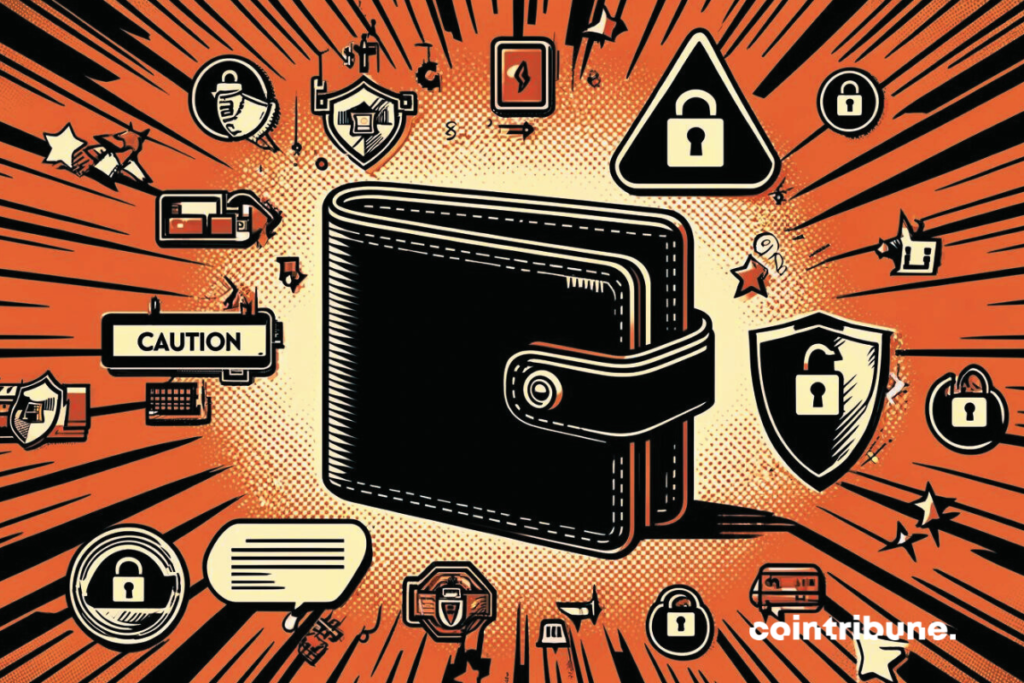
In the digital age, cryptocurrency wallets have become essential for managing and securing digital assets. However, these portfolios are not free of risks. Cyberattacks have become more sophisticated, exploiting security vulnerabilities in wallets for malicious purposes. Overview of the main flaws in crypto wallets and strategies to protect assets from any danger.

The main security vulnerabilities of wallets
Wallets are very useful for storing cryptos. However, they present several vulnerabilities. Here are the main flaws of these wallets.
Software flaws
Software vulnerabilities in crypto wallets can include bugs or programming errors that leave openings for attacks exploiting these vulnerabilities to steal funds or access sensitive data. These vulnerabilities can result from insufficiently tested updates, outdated code, or inadequate integration of new crypto features.
User interface failures
User interface failures refer to application designs that can mislead users, leading them to make costly mistakes like sending crypto to incorrect addresses or accidentally exposing private keys. A poorly designed interface can also make it difficult to understand the security options available, increasing the risk of human error.
Phishing attacks
Phishing attacks are among the most common and pernicious threats that crypto wallet users can face. They occur when malicious actors send fraudulent emails, messages, or websites in an attempt to trick users into disclosing sensitive information, such as private keys or passwords. These attacks are often disguised to appear incredibly legitimate, fooling even the most savvy users.
Malware and ransomware
Malware and ransomware are real threats to the security of digital crypto wallets. Malware is malicious software designed to infiltrate and damage systems without user consent. Ransomware, on the other hand, locks access to user files and demands a ransom for their release. Wallets can be compromised if a user accidentally downloads malware that specifically attacks wallets by trying to steal private keys or monitoring transactions.
Brute force attacks
Brute force attacks are used by cybercriminals to gain access to crypto wallets by repeatedly guessing the private key or password until they find the correct combination. Although these attacks may be rare due to the length and complexity of modern private keys, they remain a viable threat, especially if passwords are weak or predictable.
Man in the Middle Attacks
Man-in-the-middle (MitM) attacks are strategies where a hacker intercepts communication between two parties without either party realizing it. In the context of crypto wallets, this can mean the interception of transactions or connection data. The hacker can alter the information exchanged. It can change the destination address of a cryptocurrency transaction and siphon funds.
Security at the heart of crypto experts’ concerns
At this month's Blockchain Life conference in Dubai, Alvin Kan, COO of Bitget Wallet, joined experts from SafePal, Ledger, Trust Wallet and Telegram Wallet to discuss the strategies needed to offer safer and more user-friendly decentralized crypto wallets. The discussion focused on the comprehensive application of various wallet technologies, including hot wallets, cold wallets, MPC wallets, AA wallets and multi-signature wallets.
Alvin Kan highlighted the need to implement a comprehensive security solution, ensuring that security measures are introduced at every stage of the user journey, as well as every phase of the back-end, to ensure thorough construction, expansion and re-evaluation of the wallet's security settings.
Alvin Kan also gave a comprehensive analysis of the security settings implemented by Bitget Wallet to counter these issues. Indeed, Bitget Wallet offers important security features.
To begin, Bitget Wallet implements a $300 million, fully transparent and traceable on-blockchain protection fund that serves as additional collateral for user assets.
Furthermore, the wallet excels in phishing prevention and token examination. With an advanced system for identifying phishing sites and high-risk contract addresses, users receive real-time alerts, helping them avoid traps set by malicious actors.
Bitget Wallet's approach to asset storage is also best-in-class, supporting hardware wallet storage and Multi-Party Computation (MPC) solutions. This diversified asset management strategy minimizes risk and maximizes security. Additionally, the credibility of Bitget Wallet's security system is reinforced by regular audits carried out by industry leaders like Certik and SlowMist, ensuring rigorous and continuous verification of contracts.
However, the war against malicious activity does not stop there. It is important to stay informed about the latest threats in the market to ensure the best possible crypto experience.
Maximize your Cointribune experience with our 'Read to Earn' program! For every article you read, earn points and access exclusive rewards. Sign up now and start earning benefits.
A graduate of Sciences Po Toulouse and holder of a blockchain consultant certification issued by Alyra, I joined the Cointribune adventure in 2019. Convinced of the potential of blockchain to transform many sectors of the economy, I took the commitment to raise awareness and inform the general public about this constantly evolving ecosystem. My goal is to enable everyone to better understand blockchain and seize the opportunities it offers. I strive every day to provide an objective analysis of current events, to decipher market trends, to relay the latest technological innovations and to put into perspective the economic and societal issues of this ongoing revolution.
Disclaimer:
The content and products mentioned on this page are in no way endorsed by Cointribune and should not be construed as its responsibility.
Cointribune strives to provide readers with all useful information available, but cannot guarantee its accuracy and completeness. We urge readers to educate themselves before taking any action relating to the company, as well as to take full responsibility for their decisions. This article should not be considered investment advice, an offer or an invitation to purchase any products or services.
Investing in digital financial assets involves risks.
Read more
